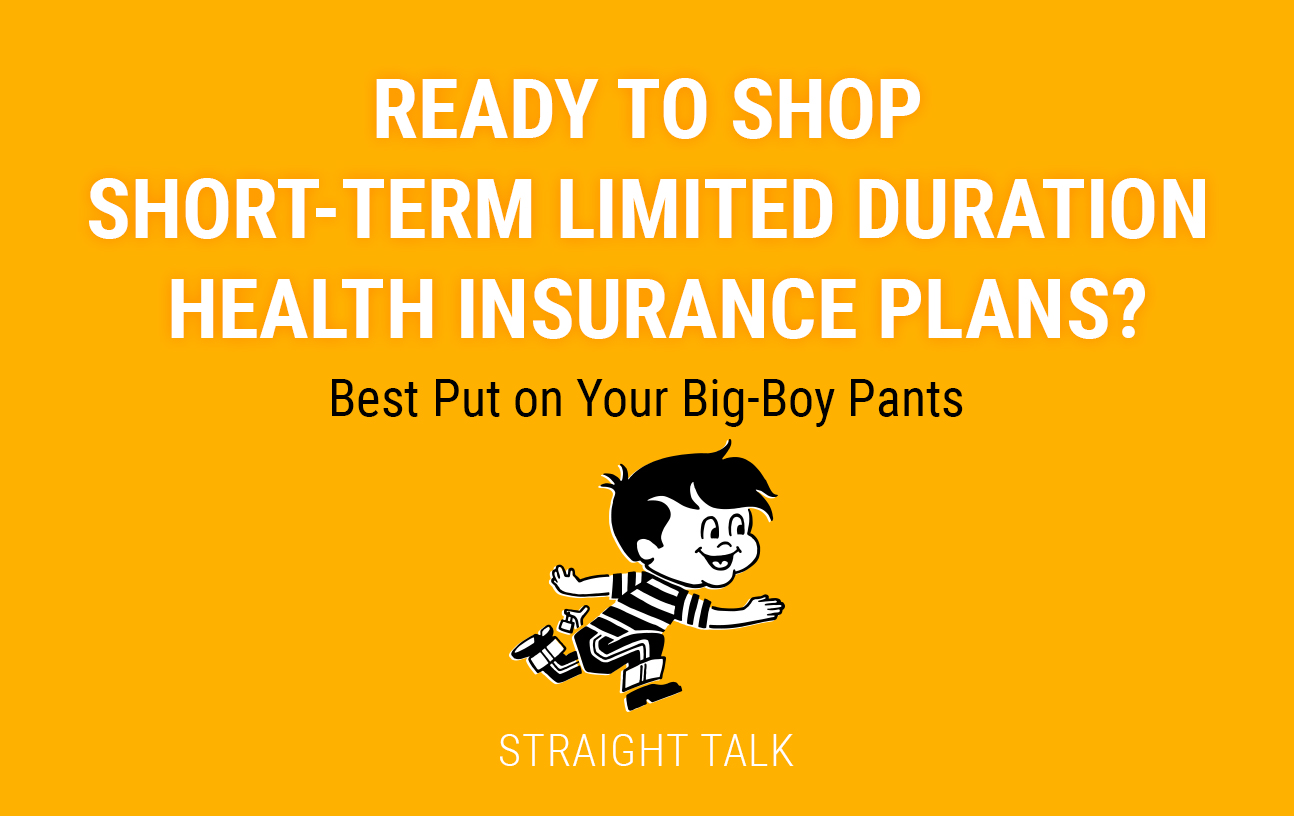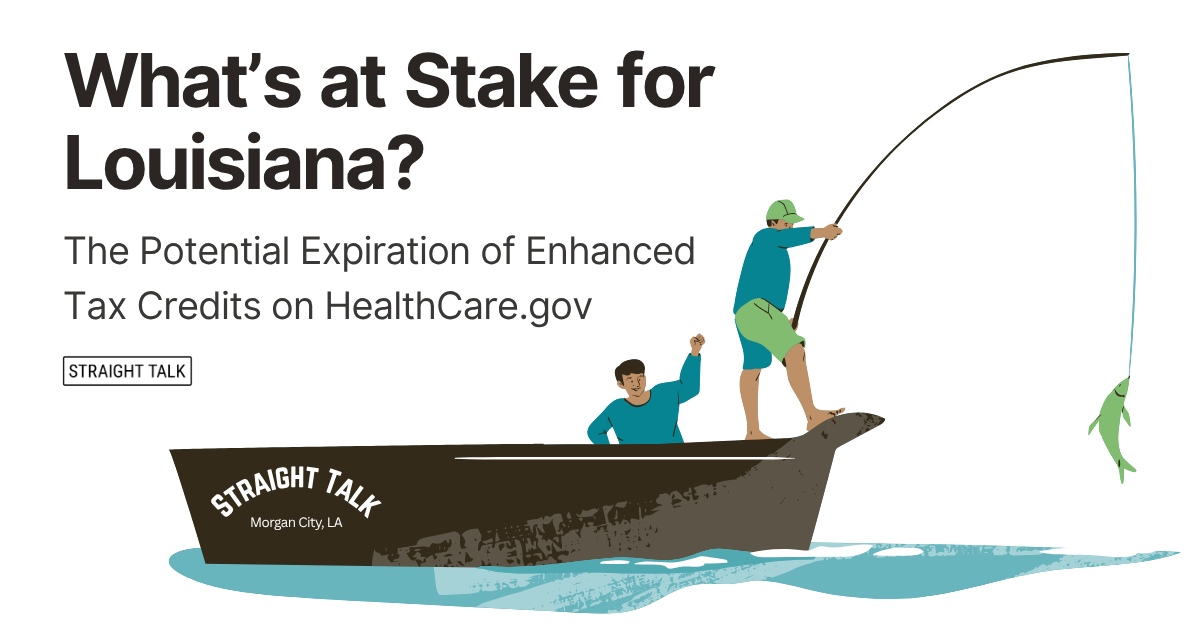When I was a little boy growing up in Morgan City in the 1960s, I had a baseball coach who seemed like he was 100 years old! “Coach Charlie” had been coaching Little League in our town for 30 years, and I was lucky enough to be on one of his teams right before he hung it up.
Whenever we were losing a game (which we did quite often!), he would gather us around and say, “You can win this game, but you all need to focus, try hard, pay attention and put on your big-boy pants!”
That really zoomed me in on that expression. For the rest of my life, “putting on your big-boy pants” meant it was time to do something important that required a little more focus and effort than you might give otherwise. Just that something extra.
What does this have to do with health insurance? Well, moving into the individual insurance market as I write this are new, expanded option, Short-Term Limited Duration Health Insurance plans (STLD). Should you shop for or buy one of these? Let me tell you what I think about them and give you some tips if you decide to go down this road. But, you need to put on your big-boy pants first and understand exactly what you are buying before you decide.
WHAT ARE THEY?
STLD is health insurance, pure and simple. It is designed to be bridge insurance that gets you from one type of permanent health insurance to another when there’s a gap. For example, people who are between jobs, moving to another coverage area, etc., can use STLD as a way to have ongoing insurance while making life changes that affects their insurance. For some folks, and thanks to new, expanded regulations, that bridge might now stretch for a few years. That’s not necessarily a bad thing, as long as you know what you’re getting yourself into.
For the past four years, all the permanent health insurance in the marketplace has been Qualified Health Plans (QHPs) that are controlled and approved by the U.S. government through their newly created regulatory agency, the Center for Consumer Information and Insurance Oversight (CCIIO).
As you might have guessed, all this was created in 2010 with the passage of the ACA, and the goal was to set a very high standard for what individual policies had to cover and regulate them at the FEDERAL level, not the state level as had been the case pre-ACA. QHPs come from healthcare.gov and cover all of the essential health benefits listed in the ACA. STLD plans are not as rich a standard of coverage. That means they don’t cover as many things as a QHP.
The QHP requirements are why individual policies today are issued to anyone who buys them, without regard to pre-existing conditions or health status, why they are sold on a federal website (healthcare.gov in Louisiana) and why their coverage is so extensive and broad. It is also why the price of them has more than doubled since 2013.
You see, prior to the launch of these ACA plans, an insurance company could vary the rate it charged you for your coverage based on health factors the company observed when you applied. In some states, they could even deny you coverage because you were too sick (although this was a much rarer event than you might think). The ACA demanded that insurance connecting prices to medical conditions be outlawed, and so it was, starting in 2014. The only exception was for STLD plans, which were limited to a max of 90 days in duration.
An executive order issued this summer changed the 90-day duration to 364 days (one day short of a full year), with up to two renewals, almost three years of coverage total. As a result, the number of companies offering these plans that allow your rate to be based on your health status, has skyrocketed.
There are IMPORTANT differences between an STLD plan and a QHP that you must be comfortable with if you are considering one.
WHY IS AN STLD PLAN NOT A QHP?
First of all, if you decide to shop for an STLD plan, you will be asked medical questions and usually have to give permission for the insurance company to look at your pharmacy records before you are given a rate or sold a policy.
These plans can be 40, 50, even 60% cheaper than QHPs, but someone with a lot of health conditions will typically not qualify and will be redirected to healthcare.gov to shop for a QHP. Most STLD plans do not cover pregnancy, or if it does, it covers it with a very large deductible. So if you are a person with lots of chronic conditions, or taking expensive medications, or a pregnant female, or thinking of becoming pregnant, STLD coverage is NOT for you.
Second, there are almost no federal regulations about what an STLD plan HAS to cover. Often, state law will intervene (these types of plans are outlawed completely in some states), but the type of coverage requirements you see in policies on healthcare.gov are not required in STLD coverage. You cannot expect to have the same coverage in an STLD policy that you would have in your insurance at work, either. It is CRITICAL that when you are shopping for an STLD that you understand EXACTLY what is covered before you buy it.
Third, STLD policies can (and do) put policy limits on things like physical therapy, home health, occupational therapy and total healthcare spending. In other words, STLD plans have a limit of coverage in dollars that you can hit, and then your insurance is over. It’s sort of like life insurance or car insurance. Make sure you know exactly what the limits are in any STLD policy before you apply. QHPs are not allowed to have dollar limits on anything, nor can there be a lifetime limit on the policy.
Finally, there is no guarantee of renewability in an STLD plan. If you get sick while you are covered under one, once the policy ends, the carrier selling it can tell you bye-bye. Of course, we now have the QHPs on healthcare.gov to fall back on, but it is possible your policy would end in the middle of the year, when healthcare.gov is not open.
Once the policy term runs out (and usually STLD plans can be bought from one to 11 months’ duration), your health can be re-evaluated before the policy is renewed. It’s also important to remember that if your STLD plan ends mid-year, that is not considered a qualifying event, which would let you buy a policy on healthcare.gov outside of Open Enrollment. You may well have to wait until the next Open Enrollment Period and be uninsured during the interim.
Make sure you are super clear on these things before you shop for or purchase STLD plans.
SO MIKE, WHO WOULD BUY THESE POLICIES?
Frankly, I expect there to be a large market for STLD plans. We’ve already observed that tens of thousands of people who purchased policies on healthcare.gov drop that coverage before the end of the year. When we drill through to see who they are, we find them to mostly be young, healthy and uninsured, and the price of coverage is what drove them away from healthcare.gov QHPs.
These seem to be perfect candidates for STLD policies to hold them over until the next Open Enrollment Period on healthcare.gov.
You’ve seen me write before about the horrible inequities in healthcare.gov pricing, where carriers are mandated by CCIIO to charge younger folks double what they should be paying in order to give a small subsidy to the 55-64 crowd. STLD plans will be priced so that they are fair and great bargains for the young and the healthy.
OK MIKE, IS BLUE CROSS GOING TO SELL STLD PLANS?
Absolutely. And our product will be the class of the marketplace! It’s called Bridge Blue.
We offer and sell Bridge Blue in a VERY transparent way, through our highly trained agent force who will explain every single nuance to every customer. Each customer will get in writing the differences between STLD plans and QHPs on healthcare.gov.
Our product is a high-quality insurance product with multiple options built on our existing networks, lots of coverage for many of the important healthcare services you might need, and a $1 million policy limit for one to 11 months of coverage. Bridge Blue will even INCLUDE the 46 different $0 copay services specified in the healthcare.gov QHP plans!
But, Bridge Blue WILL NOT include any contraceptive coverage, not even through the drug benefit. Only a procedure resulting in permanent sterilization would be covered via the medical benefit. Let me be clear: The drug benefit doesn’t include any birth control at all.
Let’s get into more detail about the product and you can decide for yourself if STLD plans are right for you:
WHAT BRIDGE BLUE WON’T COVER:
- Newborns. These policies are only available to people ages one through 64. Remember, a birth IS a special enrollment trigger to purchase on healthcare.gov, and a newborn policy can go back up to 60 days.
- Maternity. The policies include maternity coverage, but with a $7,500 out-of-pocket deductible that does not accrue to the maximum out of pocket.
- Free birth control or any other contraceptive coverage.
- Pediatric dental or vision.
WHAT BRIDGE BLUE DOES COVER:
- Office visits
- ER services
- Inpatient hospitalization
- Mental healthcare
- Substance abuse disorder
- Behavioral health treatments
- Preventive and wellness services (not including contraceptive coverage)
- Chronic disease management
WHAT ABOUT THE PRICE?
We expect relatively healthy applicants to get coverage for 40, 50 or even 60% below the price of a comparable plan on healthcare.gov. Younger individuals especially, so abused in pricing on healthcare.gov, should see significant savings when they purchase STLD plans.
If you would like to check out one of these policies, I strongly advise you do business with an insurance carrier that has a STRONG, LOCAL presence — one that is financially sound and has a good reputation in Louisiana.
Since this coverage is not federally specified, the reputation and products of the insurance company are critical to getting a good STLD plan.
Straight Talk is, these plans are not for everyone, but they can be a huge benefit to the right customers.





How can a producer get fully informed re Bridge Blue?
Will long time brokers with Blue, such as myself, be able to market these plans and if so, how would we get trained or as Lou put it, become fully informed?
The same folks who market Individual Products for us, and have passed their Healthcare.gov training courses should be able to join STLDI sales. Be sure to contact your BCBSLA Individual Rep to make sure….thanks..mrb